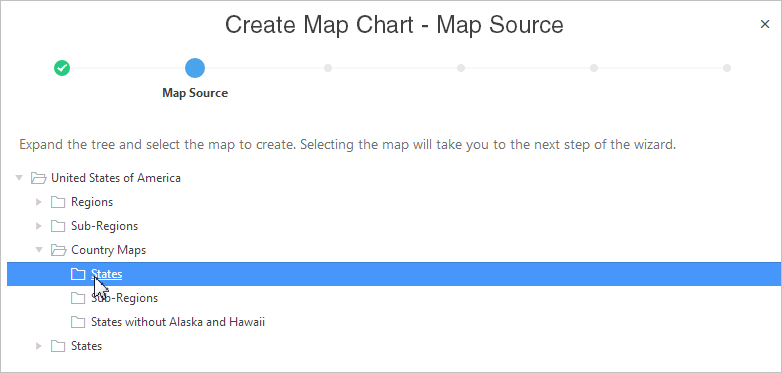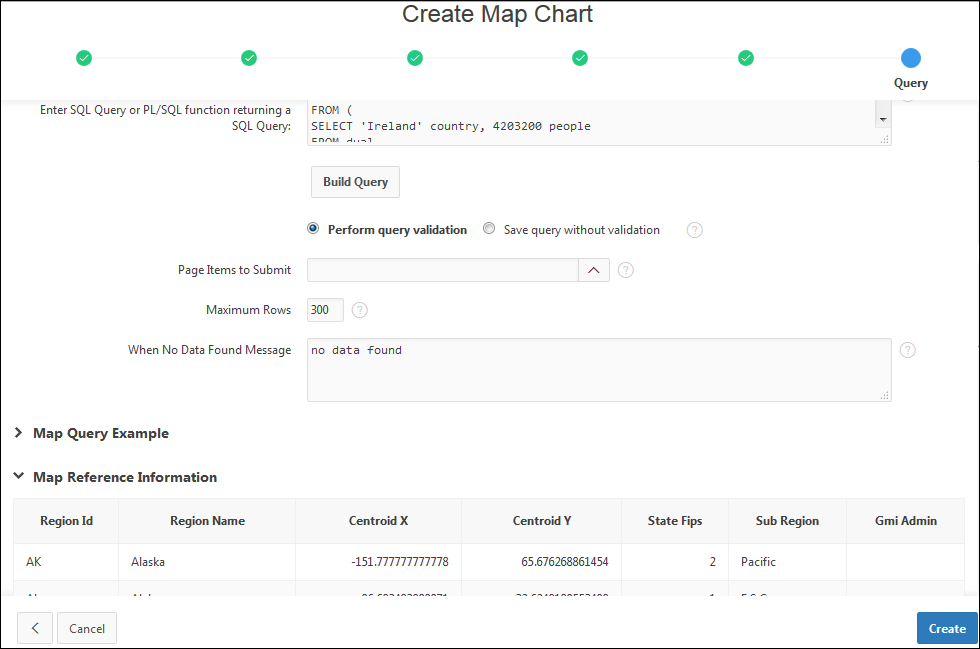25.4 Creating Legacy Maps
App Builder includes built-in wizards for generating map charts. How you create a map chart depends upon whether you are adding the map to an existing page, or adding a map on a new page.
Note:
Although still supported, map charts have been categorized as a legacy component and may be deprecated in a future release. To learn more, see "Removal of AnyChart Flash Components from Images Folder" in Oracle Application Express Release Notes.
- About Map Chart Support
Map chart support in Oracle Application Express is based on the AnyChart AnyMap Interactive Maps Component. - About Creating SQL Queries for Maps
Define a map chart by providing a SQL query with a specific syntax. - Adding a Legacy Map Chart to a New Page
Add a map chart to a page by running the Create Page Wizard. - Adding a Legacy Map Chart in Page Designer
Add a map chart by manually creating it in Page Designer.
Parent topic: Managing Application Legacy Components
25.4.1 About Map Chart Support
Map chart support in Oracle Application Express is based on the AnyChart AnyMap Interactive Maps Component.
AnyMap is a flexible Macromedia Flash-based solution that enables developers to visualize geographical related data. Map charts are rendered by a browser and require Flash Player 9 or later. For more information about AnyChart, go to http://www.anychart.com
AnyChart stores map data in files with a *.amap extension, and supports 300 map files for the United States of America, Europe, Asia, Europe, Africa, Oceania, North America, and South America. To render a desired map, you select the map source in the wizard (for example, Germany) and the map XML automatically references the desired map source .amap file, germany.amap. To browse through the available maps, see "Map Reference" in AnyChart User's Guide: http://6.anychart.com/products/anymap/docs/
Parent topic: Creating Legacy Maps
25.4.2 About Creating SQL Queries for Maps
Define a map chart by providing a SQL query with a specific syntax.
When you define a map chart providing a SQL query using the following syntax:
SELECT link, label, value FROM ...
Where:
-
linkis a URL. -
labelis the text that identifies the point on the map with which you want to associate data. The Region ID or Region Name of the map will be used as the label. -
valueis the numeric column that defines the data to be associated with a point on the map.
Consider the following example when creating a new page:
-
On the Workspace home page, click the App Builder icon.
-
Select an application.
-
Click Create Page.
-
Click Chart.
-
Select Map Chart.
-
For Map Type, select United States of America and click Next.
-
For Map Source, expand Country Maps and select States.
-
For Page Attributes specify the appropriate attributes and click Next.
-
For Navigation Preference, specify the type of navigation to include on this page and click Next. The navigation options (for example, navigation menu or tabs) depends upon the current application theme.
-
For Map Attributes, select the appropriate attributes and click Next.
The Query page appears.
-
Scroll down and expand and review the Map Query Example and Map Reference Information regions.
-
Scroll down and expand and review the Map Reference Information region at the bottom of the page.
Specify a SQL query by either:
-
Entering a SQL query in the field provided. See "About Creating SQL Queries for Maps."
-
Clicking the Build Query button. When the Build Chart Query Wizard appears, follow the on-screen instructions.
When you create your query, you must incorporate the region name information as described in the Map Reference Information region. The following example includes information for Florida and Alaska:
SELECT null link, region label, value Populations FROM ( SELECT 'Florida' region, 18328340 value FROM dual UNION ALL SELECT 'Alaska' region, 686293 value FROM dual)
Note:
If you are referencing geographical information stored in a database table, the information must correspond with the Region information associated with the map source. For more information, see AnyChart User's Guide:
http://6.anychart.com/products/anymap/docs/Click Create.
-
Parent topic: Creating Legacy Maps
25.4.3 Adding a Legacy Map Chart to a New Page
Add a map chart to a page by running the Create Page Wizard.
To add a map chart on a new page:
See Also:
Parent topic: Creating Legacy Maps
25.4.4 Adding a Legacy Map Chart in Page Designer
Add a map chart by manually creating it in Page Designer.
To add a map chart to an existing page.
Parent topic: Creating Legacy Maps

